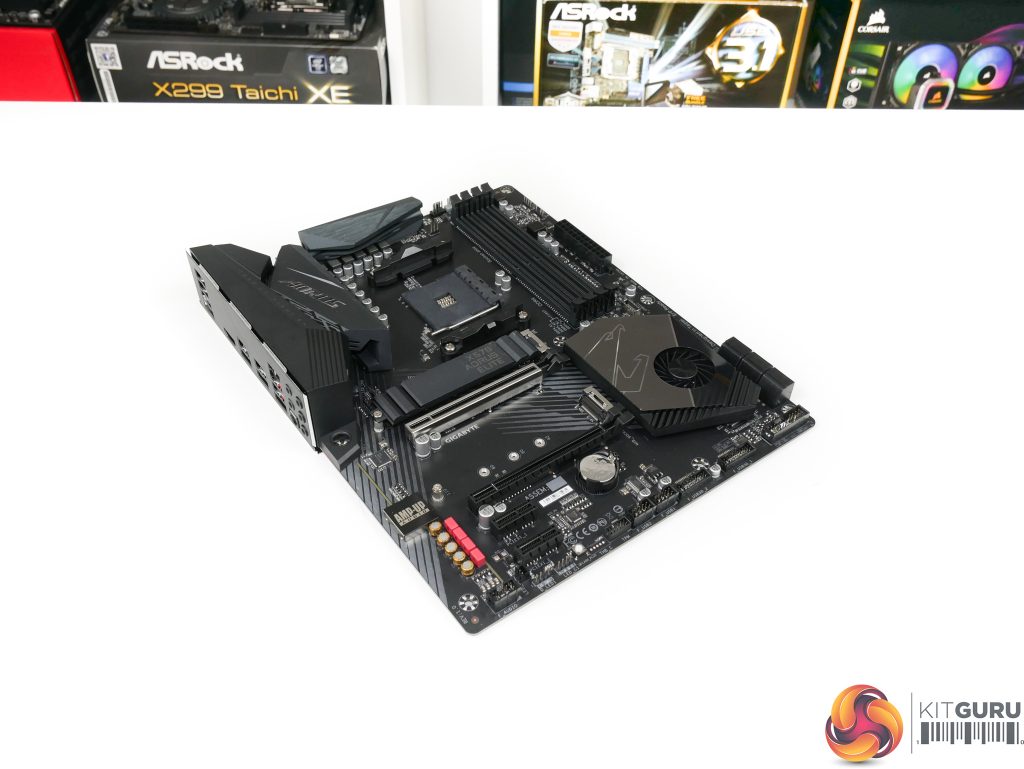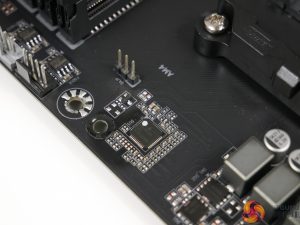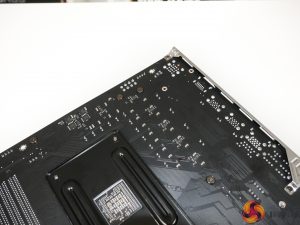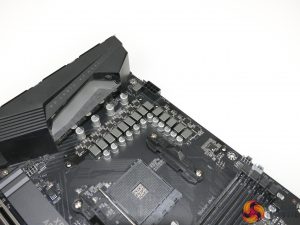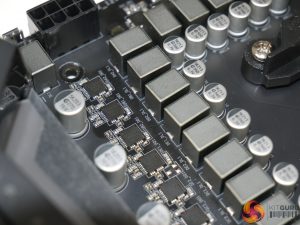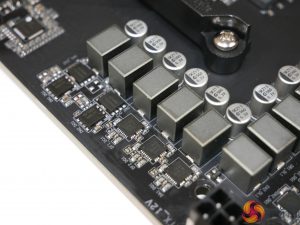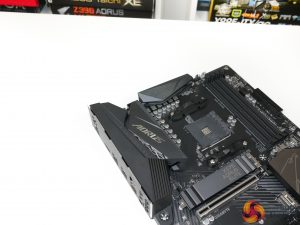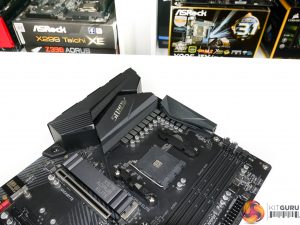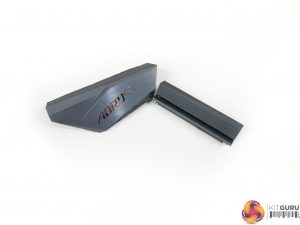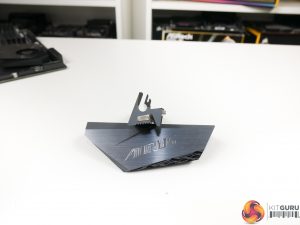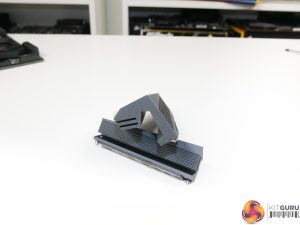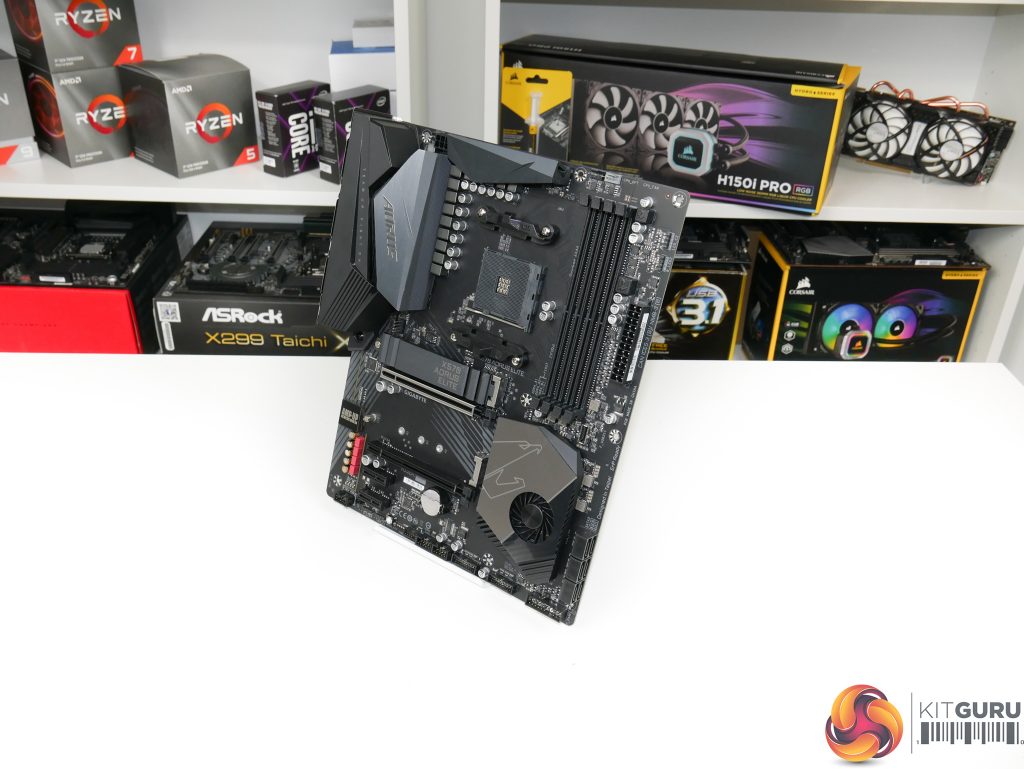Gigabyte’s £210 competitor comes in the form of the X570 Aorus Elite. Gigabyte deploys the typical Aorus motherboard colour scheme of dark greys and blacks which looks pretty good in my opinion.
Focusing on the power delivery system, Gigabyte equips this motherboard with a 12+2 phase physical implementation.
Gigabyte is using the same Intersil ISL69147 PWM controller as ASRock. Again, this is a dual output digital PWM controller that supports up to seven total control phases in an X+Y configuration. With Gigabyte, however, this seven-phase capability is utilised with the assistance of seven ISL6617A phase doublers, all of which are mounted on the rear of the PCB in an un-cooled position.
The combination of ISL69147 PWM controller + seven ISL6617 phase doublers gives Gigabyte’s X570 Aorus Elite an electronic VRM system of 6×2 + 1×2. So, the CPU VCore VRM is made up of six doubled phases while the SoC VRM gets one doubled phase.
Focussing specifically on the 6×2-phase CPU VCore MOSFET solution, Gigabyte is using the same Vishay SiC634 DrMOS power stages as ASRock. Gigabyte, however, deploys a total of twelve power stages compared to ASRock’s eight. Just in case you forgot the numbers since our ASRock reference, these co-packaged power stages are advertised with a 50A current capability for continuous output, though they do support a 10% higher current load for 10ms bursts. As we have already mentioned, these are solid power stages to use on a £210 X570 motherboard, especially when Gigabyte is deploying a dozen of them specifically for the CPU VCore VRM.
The 1×2 phase SoC VRM is driven thanks to one PWM signal from the Intersil controller and the use of a doubler.
Gigabyte deploys basic On Semi 4C06N and 4C10N high- and low-side MOSFETs to drive the SoC VRM. Despite being one PWM signal doubled to two electrical phases, Gigabyte doubles this again to make four physical phases worth of electrical components. This can be viewed as a fat, doubled, two phase design. Four 4C06N MOSFETs are used with two on the front and two on the rear. The exact same mounting is used for the four 4C10N MOSFETs. As the On Semi MOSFETs are not DrMOS solutions – they’re effectively ‘dumb’ FETs – Gigabyte is also forced to deploy two Intersil ISL6625A driver ICs on the rear.
The SoC VRM is undeniably basic in terms of electrical component quality. However, this is likely to be a non-issue for most X570 users who will be running with a dedicated graphics card.
Assessing the CPU VCore alone, Gigabyte’s 12-phase doubled solution is practically identical to that used on the £300 ASRock X570 Taichi. That’s a clear positive for Gigabyte’s £90 cheaper board.
One area where Gigabyte looks to have gone for a basic component representative of this board’s price tag is with the capacitor choice. The 5,000 hour rated capacitors are likely to be fine for almost all situation when the extended lifespan at lower running temperatures is accounted for. However, both ASUS and ASRock look to be using higher-rated alternatives that may be slightly be for longevity… if you plan to keep this board pushed hard forever … which you shouldn’t.
Also worth noting is that Gigabyte provides a single 8-pin CPU power connector. But that simply won’t be an issue unless you opt for extreme cooling solutions on the CPU.
Continuing the heatsink trend, Gigabyte designs the X570 Aorus Elite’s heatsinks with more focus on design than cooling performance. There’s no real attempt to increase surface area by using vertical fins. With that said, a similar approach to ASUS is applied where the heatsink is somewhat split into tiers in a small effort to increase surface area.
Mounting pressure is good thanks to the screw fit and the thermal pad looked to be of an appropriate thickness.
The larger left-side heatsink weighs 133 grams while the smaller top heatsink is 60 grams. That roughly 2:1 heatsink mass split looks to be pretty smart as the heavier left-side heatsink is tasked with handling nine of the CPU VCore power phases while the smaller top-side heatsink manages three CPU phases and the two SoC phases.
Balancing the thermal load of the 12-phase CPU VRM across two heatsinks is a smart solution that ASUS also deployed. In Gigabyte’s design, the left-side heatsink will have to manage around 75% of the resistive heat output from the SiC634 power stages, while the top-side will deal with around 25%.
Gigabyte is using a 4-layer ‘normal loss’ PCB on the X570 Aorus Elite. That’s step-down from some of the higher-end offerings in Gigabyte own X570 line-up, and it isn’t quite as good as ASUS’ 6-layer.
 KitGuru KitGuru.net – Tech News | Hardware News | Hardware Reviews | IOS | Mobile | Gaming | Graphics Cards
KitGuru KitGuru.net – Tech News | Hardware News | Hardware Reviews | IOS | Mobile | Gaming | Graphics Cards


